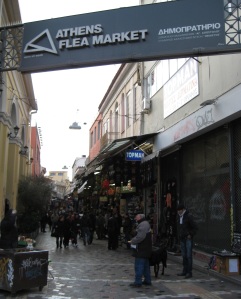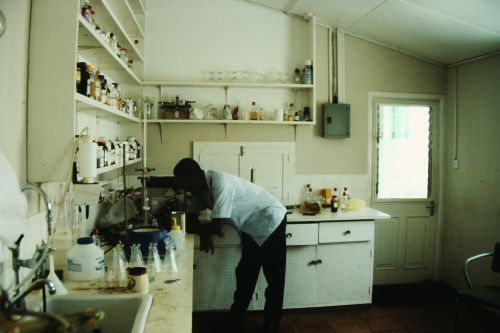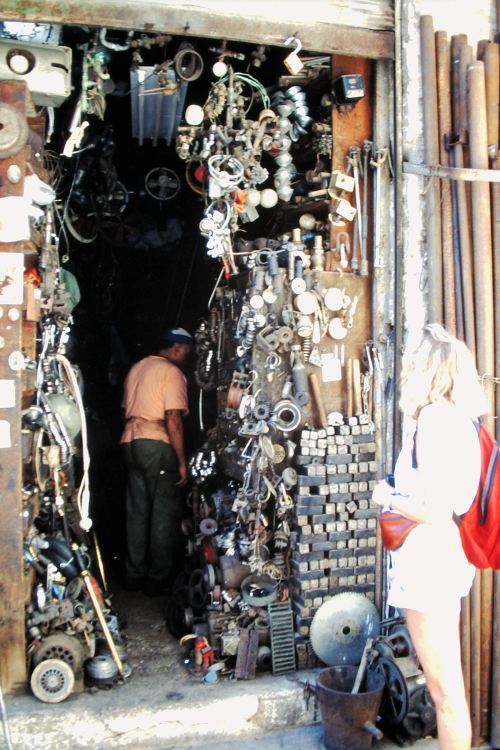 The central area of Athens, Greece, near the Governmental Parliament Building, offers a wealth of joy to the visitor or the local. This area has something for everyone. From the people watching, to food, to touristy trinket stores, and to some fine specialty stores, all engage the traveler on foot. The narrow and cobble-stoned streets warrant good walking shoes. The vendors of the small establishments often lean outside the doorway and beckon the foot traffic. Smaller side paths lead to more treasures and more obscure wares. A store that is a wall on which hang antique door-knockers could be a good example. The owner would be a specialist in that trade. Commerce is brisk in many shops, as there are lots of people. As it is said, “better buy it now, as it won’t be here next time”, is very true in the Flea Market.
The central area of Athens, Greece, near the Governmental Parliament Building, offers a wealth of joy to the visitor or the local. This area has something for everyone. From the people watching, to food, to touristy trinket stores, and to some fine specialty stores, all engage the traveler on foot. The narrow and cobble-stoned streets warrant good walking shoes. The vendors of the small establishments often lean outside the doorway and beckon the foot traffic. Smaller side paths lead to more treasures and more obscure wares. A store that is a wall on which hang antique door-knockers could be a good example. The owner would be a specialist in that trade. Commerce is brisk in many shops, as there are lots of people. As it is said, “better buy it now, as it won’t be here next time”, is very true in the Flea Market.
Take a stroll through this area. Getting to the flea market is easy. If you are coming from Syntagma Square you will be walking down Metropolitan Street, past the Cathedral and the square of shiny marble. There is a small Byzantine church in the shadow of the cathedral that you should take a look at called Agios Eleftherios. I love the peace and solemn quiet in this space. The church has an Icon inside which they say performs miracles. There are some cafes in the square and this is where Pondrossou Street begins. This section of Pondrossou is the high-end section of Monastiraki. There is a lot of touristy stuff here. I bought a wonderful Bouzouki guitar here from John’s Music Store. But in my opinion, the really cool stuff is on lower Ermou and across on small streets. If you seek originality and real antiques leave Monastiraki behind and wander around Psiri.
If you continue through the square you will come to Ermou and if you cross into Psiri there are people selling there too. The further you go the weirder it gets and by the time you get down towards Pireos Street you have very poor people buying and selling from piles of rags and little gypsy children running barefoot. Some shops are not even stalls, only things hanging a some wall. All is for sale. So… Gypsy, bad, bad, bad!
 Gypsies are skinny and invisible to the human eye. They know where every wallet is in the world. Then they are quicker than the fastest I have ever seen, ( personal ). Your Sock “might” be safe. Here is an example of one stealth group gypsy action, [sadly from personal experience, from a time ago] : I don’t look like a tourist, just a Westerner, Plus, I stay away from the logos on the clothing and designer accents. These are a beacon of light to the gypsies. The thieves work the odds and the angles. Groups in skinny teams quietly surround the mark, i.e., the Metro train commuter, a narrow cafe; close in, as in a crowded space; press against the (now) victim; and fleece every zipper, pocket, nook and crannies. When the train opens at the station, the Gypsies evaporate and all is gone. Do not get in that position ever. Hint: position a mouse trap in your back wallet pocket! Wait for the …snap and scream!
Gypsies are skinny and invisible to the human eye. They know where every wallet is in the world. Then they are quicker than the fastest I have ever seen, ( personal ). Your Sock “might” be safe. Here is an example of one stealth group gypsy action, [sadly from personal experience, from a time ago] : I don’t look like a tourist, just a Westerner, Plus, I stay away from the logos on the clothing and designer accents. These are a beacon of light to the gypsies. The thieves work the odds and the angles. Groups in skinny teams quietly surround the mark, i.e., the Metro train commuter, a narrow cafe; close in, as in a crowded space; press against the (now) victim; and fleece every zipper, pocket, nook and crannies. When the train opens at the station, the Gypsies evaporate and all is gone. Do not get in that position ever. Hint: position a mouse trap in your back wallet pocket! Wait for the …snap and scream!
Check out the morning meatmarkets, if available to your schedule in Psiri. In the evening, the tavernas, ouzeries, and little restaurants are authentic & the nightlife is excellent ( Cab it back to the hotel in a metered vs. “Gypsy Cab”).
The Tourism Police are an integral part of the Hellenic Police (ELAS), consisting of men and women especially trained and competent to offer tourists information and help, whenever they have any problems. They are also competent to solve minor differences between tourists and enterprises. They all speak foreign languages. You can recognise them by the shoulder badge Tourism Police on their uniforms. Tourism Police operate an emergency telephone line on a 24 hour basis (just dial 171 any day, any time, from all over Greece).











![IMG_6239[1]](https://sunkist2.files.wordpress.com/2012/07/img_623911.jpg?w=225&h=300)



